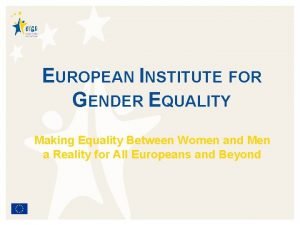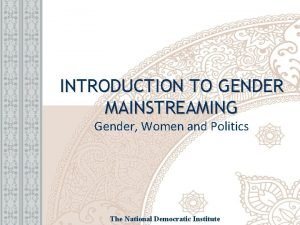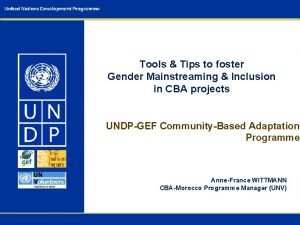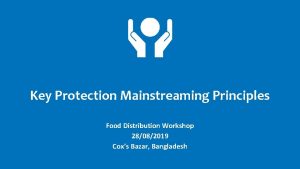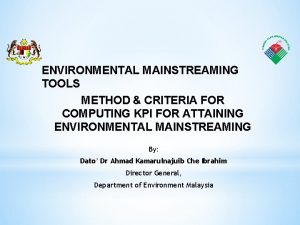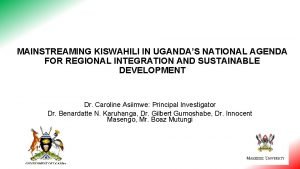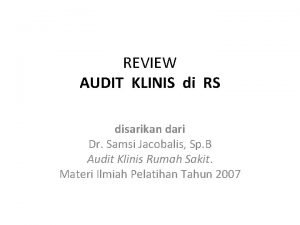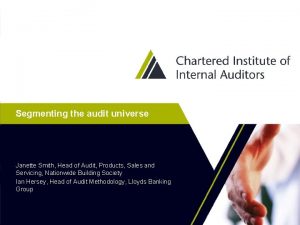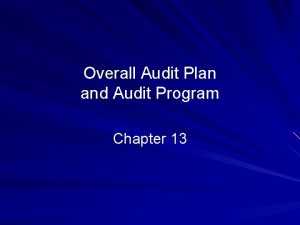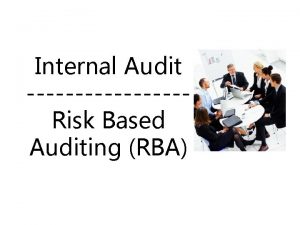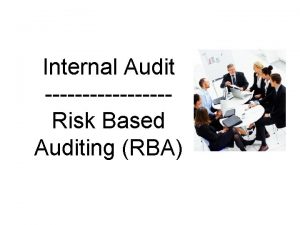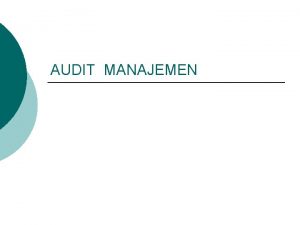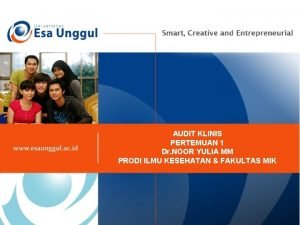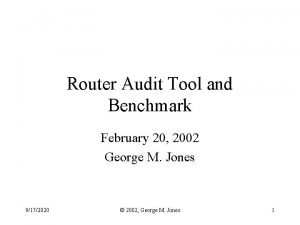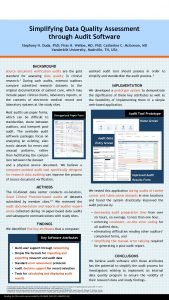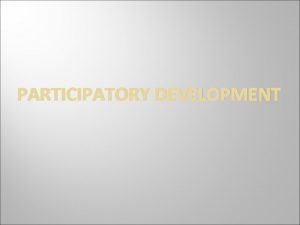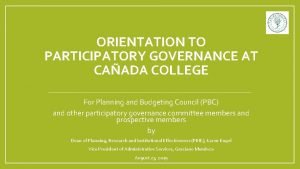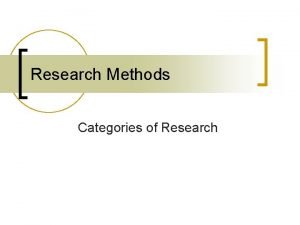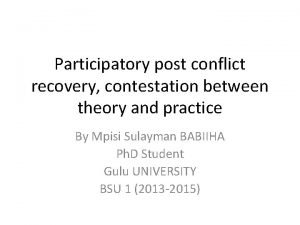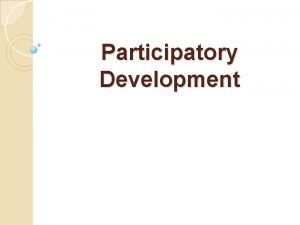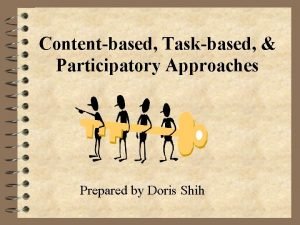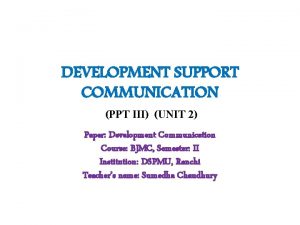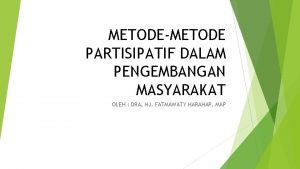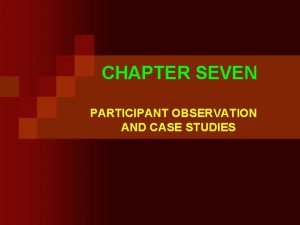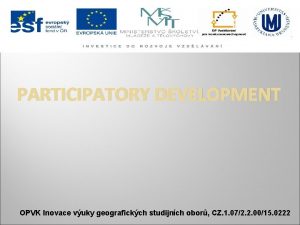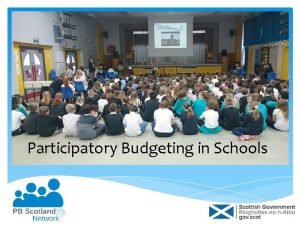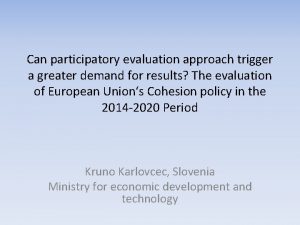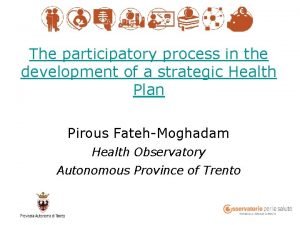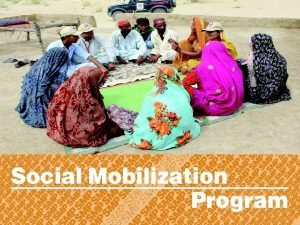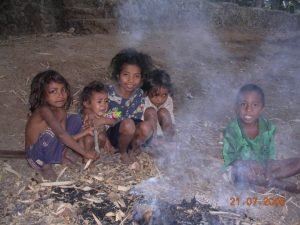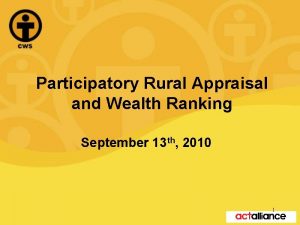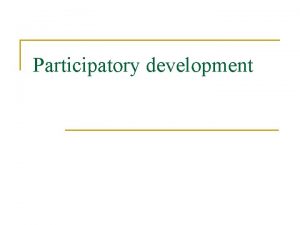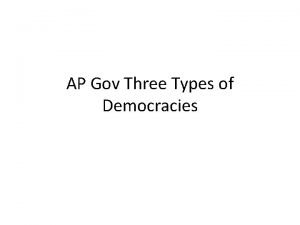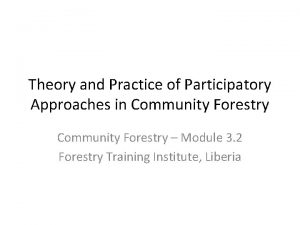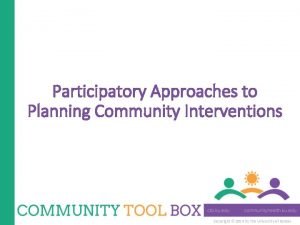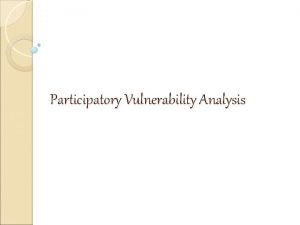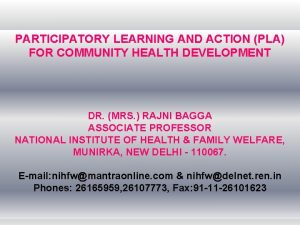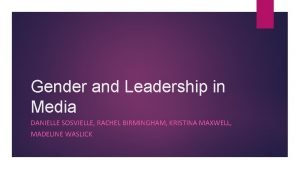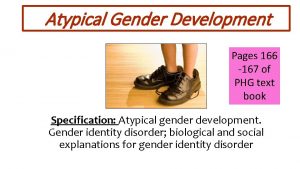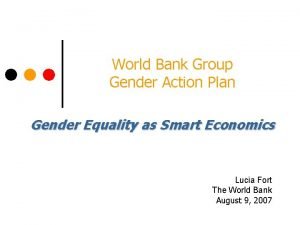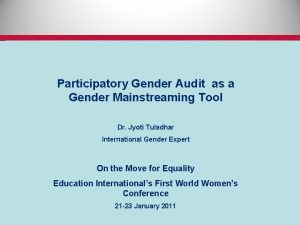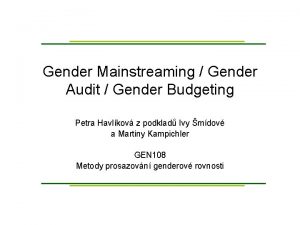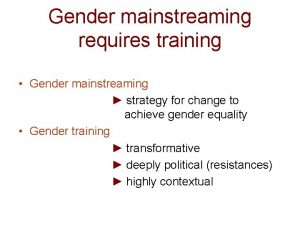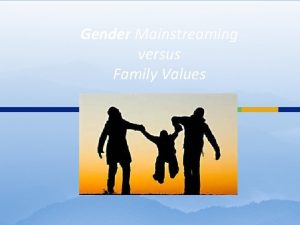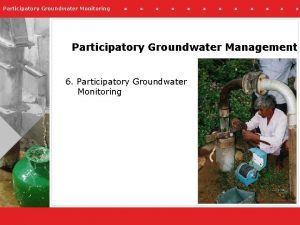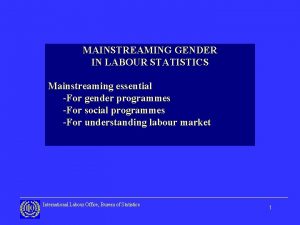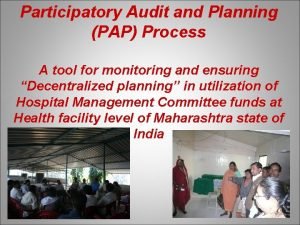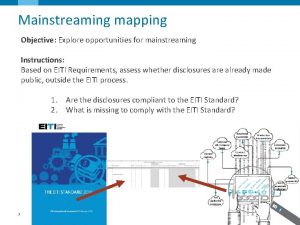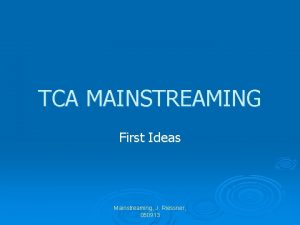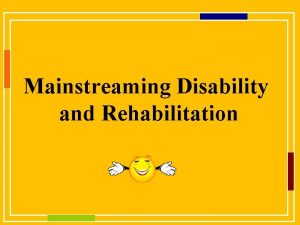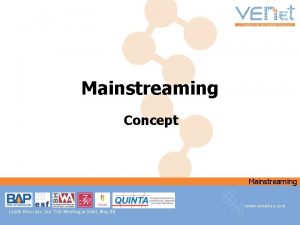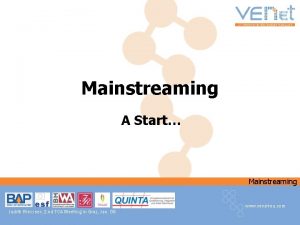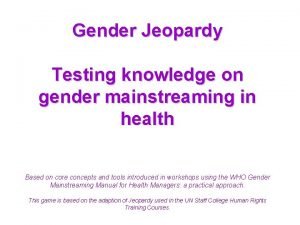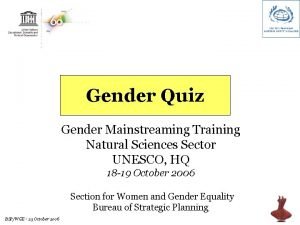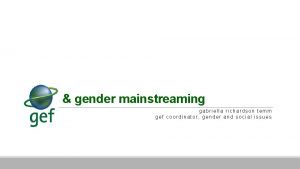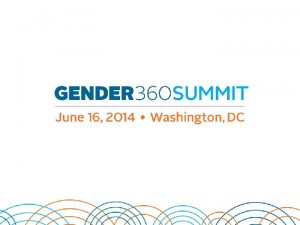Participatory Gender Audit as a Gender Mainstreaming Tool


















































- Slides: 50

Participatory Gender Audit as a Gender Mainstreaming Tool Dr. Jyoti Tuladhar International Gender Expert On the Move for Equality Education International’s First World Women’s Conference 21 -23 January 2011

ILO Gender Audits: Evolution (2001 -2009) Pioneered as “Flagship” Product in 2001 - based on participatory self-assessment methodology devised by Gender and Development Training Centre in Netherlands and adapted for the ILO First of its kind within UN system In First ILO Gender Audit (2001 -2002) main focus on auditing 15 ILO Offices/Units 8 Field Offices: Bangkok, Kathmandu, Budapest, Moscow, Beirut, Dar-es-salaam, Yaounde, Brazilia Global Desk Review of 700 ILO key policy documents and major publications • In 2003: 3 ILO audits completed: Manila, Port of Spain, Pretoria Total: 32 ILO audits ( 13 HQ and 19 Field Offices in 2004 -2009) New dimension added in 2004 by extending audits to major ILO constituents. Aim was to reach out to decision making bodies at the policy level: ILO partners: Governments, Workers and Employers’ Organizations (Sri Lanka, Yemen, Mozambique, Kyrgyzstan + ) ICFTU (ITUC); Education International (EI) Presentation + TOFs to UN Inter Agency Groups in Pakistan, Beijing, Moscow, Yemen, Kyrgyzstan and Mozambique Increasing recognition of PGA as a practical, effective and relevant tool 2

TOFs for ILO Constituents &UN groups Total of 20 TOFs to ILO tripartite constituents, partners and national experts: Asia-Pacific (Colombo, New Delhi, Kathmandu, Pakistan, Indonesia, Manila, Cambodia, Yemen, Beirut) Europe/Central Asia (Moscow, Kyrgyzstan, Ukraine) Africa (Mozambique, Tanzania, Lusaka) Total of 10 TOFs for UN agencies (7 under DFID funds and 3 with other resources) Mozambique, Abuja, Malawi, Tanzania, Addis Ababa, Cape Verde, Rwanda, Zimbabwe and Philippines Conducted supervision of both UN and ILO constituent audits Total: approximately 600 national facilitators; 250 UN facilitators and 80 ILO officials (though many no longer available within ILO) trained on PGA 3

Gender audits ILO Office Constituent UN Agency ILO headquarters 4

1. What is Unique about PGA? Quality audit” - “Social audit” as distinct from traditional financial type of audits • A tool and a process based on a participatory methodology to promote organizational learning through self assessment: - at the individual, - work unit and - organizational levels on how to practically and effectively mainstream gender Gender audit (tool) -- gender mainstreaming (strategy) gender equality (goal)

2. What does PGA do? • Gender audits look at “structures”, “processes” and “results” from a gender perspective • Facilitates identification of gender results and necessary structures & processes to be put in place by the organizations themselves • Participatory, ownership approach • Focus on individual and collective accountability, structures and process

How can PGA be used? – Monitoring tool: Assessment of the extent to which people and their organizations use a gender mainstreaming approach to achieve the gender equality goals of their organization – Evaluation tool: Combination of external and internal review and evaluation – Needs assessment & capacity building tool: Focus on: - Group learning - Creating ownership - Consensus building - Establish baseline data

PGA Key Features Participatory in approach Diagnostic self assessment Collective exercise Reflective analysis Promotes learning and ownership Consensus building Preserves confidentiality Mainly subjective based on perceptions (+objective facts)

3. Five Key Result Areas WORK TOWARDS • Coherent Policy on Gender • Gender Perspective in substantive work • Specific institutional arrangements (CM, Focal points, teams and task forces, advisory bodies) • Gender competence building strategy • Gender sensitive Human Resources Policy: gender balance in representation

Tool for Organizational Change • Securing political will and commitment (Strong and visible commitment at highest political level) • Accountability procedures: explicit policies/programmes/budget • Technical skills/expertise • Institutional Mechanisms: establishing systems and procedures for advocating and implementing issues, e. g. advocating for EO and anti-discrimination laws/regulations/

Transformational Learning Tool Based on transformational learning concepts: Dialogue: process of discussion, interaction, and exploration with others which facilitates critical analysis of the world Praxis: process of reflection in searching for the truth Conscientisation: the process of learning to recognize social, political, and economic contradictions and to take action against the oppressive elements … power to transform reality … leading to a pursuit of fuller humanity

Why is such an approach important? Because: It entrusts the organizations with the responsibility to shape their own future It entrusts people to articulate their own gender related development goals, objectives, desired outcomes and changes It helps identify necessary inputs, actionable steps, and strategies for achieving those changes Participatory processes inherently emanate ownership over individual and organizational development progress.

4 Theoretical Underpinnings A. Gender and Development Approach B. Experiential (Adult) Learning Cycle C. Qualitative self-assessment D. Knowledge management in learning organization

A. Gender and Development Approach Gender: Ideas and expectations about the characteristics, aptitudes and likely behaviour of women and men that are Socially learned, Dynamic and changeable over time and Cultural and societal variations Sex: Biologically determined differences between women and men that are universal Gender division of labour • Access to and control over resources • Power relations /perspectives and perceptions • Practical and Strategic Needs and Interests • Notions of Masculinity and Femininity

How are Gender values & norms determined? Existing socio-cultural system (Patrilineal/Matrilineal) Gender Stereotypes • • Men are bread winners, women service providers Men are natural leaders and managers Nobody will accept a woman boss. Fast track promotion: a must for promising men, a waste for promising women Institutional Permeation: Household - Community - Market – State Changes in stereotypes take place. Japan: View on: Women should stay at home. Men are paid workers. Men Women 50% 38% 1987 36% 24% 1990

Gender Equality • Equal rights and responsibilities • Equal treatment • Equal valuation of both women and men, girls and boys so that they can participate in, decide on and benefit from development on an equal footing. • Gender Equality: - Same fundamental Human Rights - Equal Value and Fair Distribution of: * responsibilities and opportunities * workload, decision making and income

What is Gender Equality? Gender equality, or equality between men and women, refers to: § Enjoyment of equal rights, opportunities and treatment by men and women of all ages in all spheres of life and work. § It implies that all human beings are free to develop their personal abilities and make choices without the limitations set by stereotypes and prejudices about gender roles or the characteristics of men and women. § It means that the different behaviour, aspirations and needs of women and men are considered, valued and favoured equally. § It does not mean that women and men are the same or have to become the same, but that their rights, responsibilities, social status and access to resources do not depend on whether they are born male or female. §

What is Gender Equity? • Also known as Gender Justice: fair treatment of both sexes that take into account and address the different needs of the men, women, boys and girls, cultural barriers and the effects of (past) discrimination of the specific group. A stork and a fox cannot eat from the same types of dishes. Equal ≠ the Same

What is Gender Mainstreaming? Adopted as the main strategy for promoting gender equality at global and national levels at Fourth World Conference on Women in Beijing in 1995. ECOSOC defines gender mainstreaming as: • • the process of assessing the implications for women and men on any planned action, including legislation, polices or programmes, in any area and at all levels; a strategy for making the concerns and experiences of women as well as of men an integral part of the design, implementation, monitoring and evaluation of policies and programmes in all political, economic and societal spheres, so that women and men; benefit equally, and inequality is not perpetuated The ultimate goal of mainstreaming is to achieve gender equality (Agreed Conclusions: E/1997/L. 30, p. 2).

B. Experiential Learning Cycle Step 1: Experiencing action Step 5: Application in real life Step 2: Sharing feelings on what happened Step 4: Step 3: Drawing conclusions Analyzing and key messages what happened

C. Qualitative Self-Assessment – – – Why are things as they are? How did we get to where we are? Why do we act the way we do? What are the forces of change? Where are the forces that make change possible? – Are we doing the right things in the right way?

D. The Learning Organization Involves assessing, learning and change at all three levels: individual, unit and organization Three loops of learning: Single Double Triple ILO Bureau for Gender Equality

5. Key Areas of Analysis 1. Relationships with current gender issues, gender debate and national gender machineries : (one/third representation of women in all state institutions – labour and employment related institutions? ) 2. Mainstreaming of gender equality concerns in the objectives, programmes and budgets of the organization (Making GE issues visible on agenda of social dialogue and tripartite institutions)

Key areas of analysis 3. Systems and instruments in use: (Institutional arrangements – mechanisms for programming, implementing, monitoring and evaluation - Accountability framework for GE to be established) 4. Existing gender expertise, competence and capacity building 5. Information and knowledge management 6. Staffing and human resources: (Gender balance in senior posts - expansion of career development opportunities for all staff - creation of family friendly and enabling working environment for all – women and men)

Key areas of analysis: Accessing Voice • • 7. Decision-making on gender mainstreaming Increasing participation: Systematic efforts to ensure greater representation in delegations, tripartite committees, seminars & training courses Increasing representation in decision making: Improved gender balance in policy making and deliberative Councils, Conference and Advisory bodies Male/female ratio: 40 -60% - Minimum 30% - of each Promoting more effective representation of women in leadership positions

Some Key Areas of Analysis 8. Organizational Culture Gender dynamics within, values and modes of behaviour 9. Products and Public Image 10. Selection of Partner Organizations

6. Gender Audits – How? Methods: – Desk review of key products of the Organization – Semi-structured individual and group interviews – Participatory workshops – Consultations with partner organizations ILO Bureau for Gender Equality

Desk review – How? § § Why review documents? What Types of documents to review? How many to review Criteria of review

Individual/Group Interviews Why interview? When to interview? Who to interview? How to Interview? ILO Bureau for Gender Equality

Participatory Workshops Core Exercises • Historical Timeline • Gender Knowledge mapping • Hofstede’s Onion • Classification of projects Optional exercises • Venn Diagram • SWOT • Mind mapping • Ideal organization ILO Bureau for Gender Equality

How to select the Facilitating Team? Critical Thinking and Learning occurs best in Environments that are Non-threatening and Open Qualities and Role of Facilitators : Team of 4 members - Non-judgemental Objective Encourage discussion of opposing views Good communicator, able to clarify complex issues Open with no «right or wrong answers» Strict confidentiality observed No manipulation or control or exertion of power over focus group

Gender Audit Timeline (Model) Time investment: 10 working days Stages: – – Preparation before the audit: critical for success Desk review and interviews: 4 days Workshops and consultations: 4 days Report writing with Summary ready at end of audit: 1. 5 day and throughout – Debriefing of Director and feedback session with Unit to validate findings and recommendations: 0. 5 day 32

Writing the gender audit report • Confidential, property of audited organization • Not more than 30 pages • Findings and recommendations • Constructive, not judgmental • Practical and realistic recommendations

Summing Up: What do we produce as OUTPUT? During the PGA After the PGA Self assessment Solution Finding Identifying strengths Gaps and challenges And analyzing them Through guided exercises and open-ended dialogue, engage participants to critically think on what changes are needed for effective gendermainstreaming Presenting findings And recommendations In collective feedback Writing the report Follow up Action Plans

Key findings from gender audits • Lack of conceptual clarity on gender concepts and gender mainstreaming • Need to make gender “visible”, “specific”, “explicit”, “concrete” and integrated • Limited exposure to gender mainstreaming tools and methodologies • Overload on gender specialists and GFPs • How to integrate gender into technical areas is the “million dollar question” • Establish benchmark for effectiveness of interventions ILO Bureau for Gender Equality

Key findings from gender audits • Need to develop mechanisms for accountability on gender mainstreaming • Lack of specific gender indicators that would help track progress made • Lack of consistency and sustainability of gender mainstreaming throughout institutional structures and mechanisms • Need for management to explore ways of highlighting and giving recognition to good practices in gender mainstreaming • Wherever sound management practices “backing up” management commitment, GMS is “taking off”

Positive outcomes • Project documents examined through a “gender filter” – screening project proposals • Creating work environment to make professional and private life more balanced - flexible working time and working from home arrangement to promote family friendly workplace • Improvement of sex balance at all levels – particularly at senior posts • Resource tracking through separate budget lines – how to make gender budgeting applicable to constituents’ needs • Improved efforts at gender mainstreaming in technical cooperation projects

Positive Outcomes • New user-friendly tools on gender and child labour published • Advocacy strategies for promoting gender equality in different programmes strengthened • Gender focal team set up to monitor implementation of audit recommendations • Country-specific vision on gender equality and gender mainstreaming strategy developed • Contribution to team building, cohesiveness and growth of culture of sharing information and knowledge on gender issues within the unit • Develop monitoring systems that are qualitative and quantitative based on participatory self assessments and peer group review • Develop more management practices that are based on promoting reflection and learning as basis for improved performance • TOFs for gender audits among constituents

Reality Check!!! Challenges faced by Unions: Ø lack of political will from some union leaders which results in low participation of women in union activities and their absence at decision- making positions in the unions and society Ø limited training opportunity for women Ø insufficient specific training related to gender and women also needs to be addressed to change the culture of the unions Ø Recruiting young women teachers and ensuring their active participation in union’s activities Ø Violence against women at the workplace Ø Balance of family and professional life Ø Equality in union leadership

Challenges … q Unions need to have their own gender policy and equity work plan q Need to generate indicators that enable unions to measure the advances regarding equality inside the structures and also in the education sector q to ensure that institutional policies on equality remain stable regardless of the changing of executive board q to work harder for inclusive education policies with gender equity perspective q To increase demand dissemination of laws against women violence q improve the percentages of women’s participation in national leadership

FNPR: Venn Diagram

Hofstede’s Onion (FNPR)

Manila Onion (UN GMC)

Pakistan, Kyrgyzstan, Indonesia, Philippines 44

Bandung and Bogor (Indonesia) 45

Kiev, Manila, Nepal 46

Kiev, Bishkek, Bandung 47

Yemen 48

Harare, Lusaka, Malawi, Jos 49

Kiev (Ukraine) 50
 Gender mainstreaming
Gender mainstreaming What is gender mainstreaming?
What is gender mainstreaming? What is gender mainstreaming?
What is gender mainstreaming? Sex videao
Sex videao Protection mainstreaming principles
Protection mainstreaming principles Environmental mainstreaming tools
Environmental mainstreaming tools Mainstreaming in swahili
Mainstreaming in swahili Strategic gender needs and practical gender needs
Strategic gender needs and practical gender needs Beda audit medis dan audit klinis
Beda audit medis dan audit klinis Vouching
Vouching Audit universe definition
Audit universe definition Penyelesaian audit dan tanggung jawab pasca audit
Penyelesaian audit dan tanggung jawab pasca audit Overall audit plan
Overall audit plan Perbedaan audit konvensional dengan audit berbasis risiko
Perbedaan audit konvensional dengan audit berbasis risiko Perbedaan audit konvensional dengan audit berbasis risiko
Perbedaan audit konvensional dengan audit berbasis risiko Kerangka kerja audit manajemen
Kerangka kerja audit manajemen Audit klinis adalah
Audit klinis adalah Perbedaan prosedur audit top-down dengan bottom-up
Perbedaan prosedur audit top-down dengan bottom-up The term audit originated from the latin word audit
The term audit originated from the latin word audit Router audit tool
Router audit tool Cisco asa configuration audit tool
Cisco asa configuration audit tool Data quality audit tool
Data quality audit tool Potter's wheel data cleaning tool
Potter's wheel data cleaning tool Participatory development
Participatory development Participatory governance
Participatory governance Objectives of a research paper
Objectives of a research paper What is participatory development
What is participatory development Participatory development
Participatory development Content based task based and participatory approaches
Content based task based and participatory approaches Communication for development ppt
Communication for development ppt Participatory impact monitoring adalah
Participatory impact monitoring adalah Participatory observation
Participatory observation Pra diagram
Pra diagram What is participatory development
What is participatory development Participatory budgeting
Participatory budgeting Participatory evaluation
Participatory evaluation Participatory process
Participatory process Participatory rapid appraisal
Participatory rapid appraisal Pengertian participatory action research
Pengertian participatory action research Wealth ranking in pra
Wealth ranking in pra Participatory development
Participatory development Ap gov pluralist democracy
Ap gov pluralist democracy Disadvantage of participatory planning approach
Disadvantage of participatory planning approach Willem van weperen
Willem van weperen Disadvantages of participatory planning approach
Disadvantages of participatory planning approach Participatory vulnerability analysis
Participatory vulnerability analysis Participatory development
Participatory development Pla tools and techniques
Pla tools and techniques Christin rachelle gender
Christin rachelle gender Gender dysphoria biological explanations
Gender dysphoria biological explanations Gender action plan world bank
Gender action plan world bank
